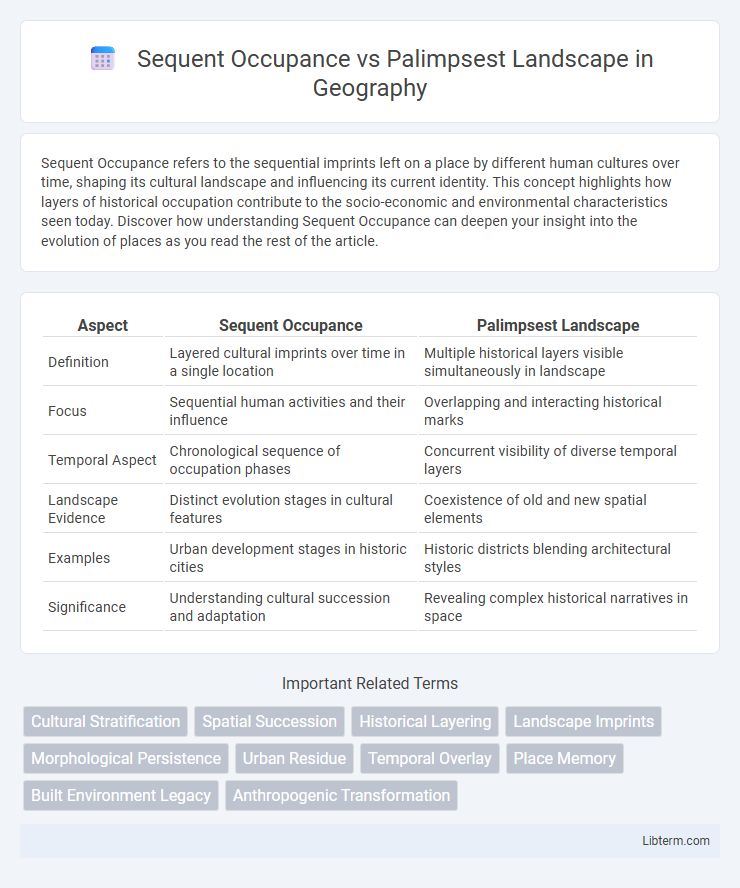Sequent Occupance refers to the sequential imprints left on a place by different human cultures over time, shaping its cultural landscape and influencing its current identity. This concept highlights how layers of historical occupation contribute to the socio-economic and environmental characteristics seen today. Discover how understanding Sequent Occupance can deepen your insight into the evolution of places as you read the rest of the article.
Table of Comparison
| Aspect | Sequent Occupance | Palimpsest Landscape |
|---|---|---|
| Definition | Layered cultural imprints over time in a single location | Multiple historical layers visible simultaneously in landscape |
| Focus | Sequential human activities and their influence | Overlapping and interacting historical marks |
| Temporal Aspect | Chronological sequence of occupation phases | Concurrent visibility of diverse temporal layers |
| Landscape Evidence | Distinct evolution stages in cultural features | Coexistence of old and new spatial elements |
| Examples | Urban development stages in historic cities | Historic districts blending architectural styles |
| Significance | Understanding cultural succession and adaptation | Revealing complex historical narratives in space |
Introduction to Sequent Occupance and Palimpsest Landscape
Sequent Occupance refers to the concept where successive societies leave their cultural imprints on a landscape, creating layered evidence of human activity over time. Palimpsest Landscape describes a similar idea, emphasizing how these overlapping historical impacts coexist and interact within the same physical space. Both concepts are essential in understanding the dynamic and multi-temporal nature of cultural landscapes in geography and heritage studies.
Defining Sequent Occupance in Human Geography
Sequent Occupance in human geography refers to the layered imprint of successive societies on a given landscape, where each group leaves behind cultural and physical modifications that shape the environment over time. This concept highlights the cumulative impact of human activities, revealing how historical societies have influenced land use, settlement patterns, and architectural forms. Understanding sequent occupance helps geographers analyze the evolving relationship between humans and their environment, distinct from the idea of palimpsest landscapes which emphasize visible traces of previous layers.
Understanding the Concept of Palimpsest Landscape
The concept of Palimpsest Landscape refers to a geographical area where multiple layers of human activity and natural processes are visibly superimposed, revealing historical, cultural, and environmental transformations over time. Unlike Sequent Occupance, which emphasizes chronological succession of cultures inhabiting a space, Palimpsest Landscape highlights the coexistence and interaction of diverse temporal layers within a single spatial context. This approach aids in interpreting landscapes as complex archives, enabling deeper analysis of heritage, urban evolution, and ecological dynamics.
Historical Layers: Tracing Cultural Imprints
Sequent Occupance refers to the sequential imprints of human activity shaping a landscape through successive cultural and historical periods, each layer influencing the spatial patterns of settlement and land use. Palimpsest Landscape highlights the coexistence of multiple historical layers visible simultaneously, where past cultural imprints overlap and interact with modern developments. Understanding these concepts aids in tracing cultural continuity and change, revealing how historical events and practices are embedded within the physical environment.
Key Differences Between Sequent Occupance and Palimpsest Landscapes
Sequent occupance refers to the sequential layering of cultural imprints by successive societies on a landscape, reflecting continuous human adaptation and modification. Palimpsest landscapes emphasize the visible traces of past human activities that coexist, creating a complex, multi-timeframe spatial narrative. The key difference lies in sequent occupance highlighting temporal succession and cultural evolution, whereas palimpsest landscapes focus on the simultaneous visibility of historical layers within a single spatial context.
Case Studies: Real-World Examples of Sequent Occupance
Sequent occupance is clearly illustrated in the layered urban development of Rome, where ancient ruins coexist beneath modern infrastructure, showcasing continuous habitation and cultural adaptation over millennia. Another prime example is the city of Istanbul, where Byzantine, Ottoman, and contemporary influences have successively shaped its architectural landscape, reflecting diverse historical epochs. These case studies reveal how sequent occupance documents human interaction with space, contrasting with the palimpsest landscape concept, which emphasizes visible traces of previous land uses often obscured but still influencing contemporary environments.
Case Studies: Notable Palimpsest Landscapes
Notable palimpsest landscapes such as Rome, Istanbul, and Jerusalem exemplify the layered historical and cultural imprints of successive civilizations, illustrating the concept of cultural sedimentation in urban morphology. These cities reveal complex spatiotemporal narratives where ancient ruins coexist with modern infrastructure, embodying a tangible dialogue between past and present urban fabrics. In contrast, Sequent Occupance emphasizes a sequential human imprint, whereas palimpsest landscapes highlight overlapping temporalities visibly integrated within a single urban environment.
Impacts on Urban Planning and Development
Sequent Occupance highlights the layered historical impacts on urban spaces, emphasizing how successive cultural groups shape city development patterns over time. Palimpsest Landscape refers to visible, overlapping traces of past urban forms that influence contemporary planning decisions, preserving historical elements while integrating new infrastructure. Both concepts guide urban planners in balancing heritage conservation with modern growth, fostering sustainable and context-sensitive city development strategies.
Sequent Occupance and Palimpsest Landscape in Modern Geography
Sequent Occupance refers to the concept in modern geography where successive societies leave lasting imprints on a landscape, shaping its cultural and physical features over time. Palimpsest Landscape expands on this by highlighting how multiple layers of human activity overlap, creating a complex, multi-dimensional record within a single geographical area. Both concepts are crucial in understanding the dynamic interactions between human history and spatial environments in contemporary geographic studies.
Conclusion: Interpreting Cultural Transformations of Landscapes
Sequent Occupance and Palimpsest Landscape models both reveal layers of cultural transformations embedded in landscapes, highlighting how successive human activities leave tangible marks over time. Sequent Occupance emphasizes discrete phases of occupation, while Palimpsest Landscape captures overlapping and erased cultural imprints, offering a more dynamic interpretation of landscape evolution. Understanding these frameworks advances archaeological and geographical analysis by decoding complex temporal narratives within cultural landscapes.
Sequent Occupance Infographic

 libterm.com
libterm.com